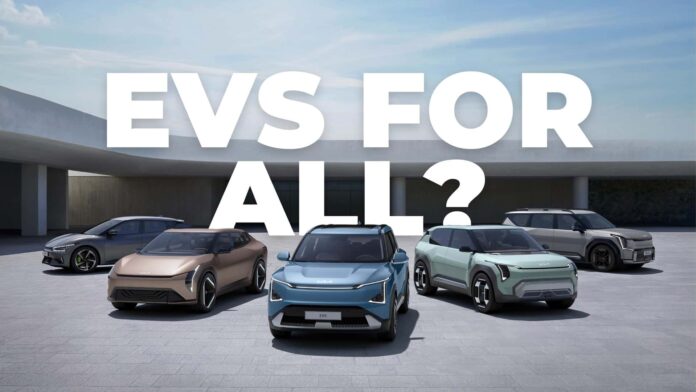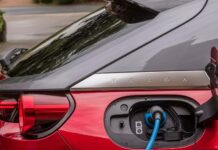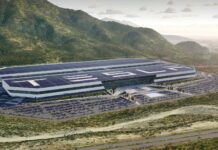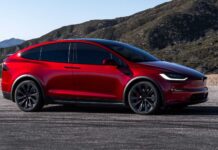[ad_1]
“EVs for all.” That’s what Kia called its electrification strategy at its inaugural EV Day event in Seoul, where the automaker publicized more of its plans to become a battery-vehicle powerhouse in the years and decades to come. And by “all,” Kia really seems to mean all. From South Korea to Slovakia to India and beyond, the Korean company has EV production and sale ambitions up there with Tesla and BYD.
It’s been no secret that the Hyundai Motor Group, which owns Kia, has emerged as one of the most serious players in the electric space. For the Kia brand alone, those goals mean EV production across eight global bases by 2025, with Korea as the “main hub,” each making differently priced passenger and commercial EVs to serve the wildly different needs of its customers worldwide. To do that, it aims for a lineup of EVs ranging from $30,000 to $80,000 globally (in U.S. dollars) and possibly below that in the future.
“Our ultimate aim is to provide unique value to as many people as possible,” Kia’s co-CEO and President Ho Sung Song told a group of reporters from across the world gathered in Seoul last week. What that means, Song and his team said, is focusing on small- and medium-sized EVs in Europe, mid- to large-sized ones for China, and increased production in North America to take advantage of the Inflation Reduction Act’s tax credits. It means large SUVs, midsize and compact crossovers and sedans, entries into completely new arenas, and swings like the planned subcompact Kia EV2 – which could become a leader in the long-awaited affordable electric segment that companies like Tesla are also said to be working on.

The world was given a fairly concrete preview of that lineup at EV Day, with the production EV5 that’s set to be made in China and Korea; the compact Concept EV3, about the size of its current Seltos; and the Concept EV4, a kind raised-height sportback sedan not dissimilar to the Polestar 2.
In particular, the EV5 is “a very important vehicle for Kia,” something that “adds much-needed momentum to the mass popularization of EVs,” said Spencer Cho, head of Kia’s Global Business Planning unit. Part of that will be its price tag, as it’s slated to cost between $35,000 and $50,000 and is sized to compete in a very popular crossover segment. However, it’s still awkwardly unclear if that car is coming to the U.S. or not. But any that do will use Tesla’s North American Charging Standard (NACS) plug soon, and be able to access its vast Supercharger network, which should make living with these EVs quite a bit easier.
The goal for Kia, Song said, is 1 million EV sales globally by 2026; a huge increase from the approximately 132,000 EVs sold in 2022. That’s ambitious, but there’s also a refreshing degree of realism involved with this plan. Kia wants 37 percent of its global sales to be all-electric by 2030, meaning it will still make internal combustion engine vehicles during that time, especially for the so-called emerging markets like India and South America where it may be tougher to build out charging networks. The plan is for EV adoption to trickle down from China, Korea, the U.S., and other, more developed markets first. And getting EV costs down in those places is going to be a crucial part of this effort.
If anything, the plan shared by Kia – which has close ties to what Hyundai and the Genesis luxury brand are doing – feels like a move to keep the Korean automakers ahead of China’s rapid EV expansion into other markets.

“We believe the key to speeding up the transition to electrification is to make the decision to switch to EVs easier for customers,” Cho added. “One of the biggest obstacles to purchasing electric vehicles is to their relatively high price compared to beakers with internal combustion engines. In response, we have created a product portfolio that covers a wide range.”
That range was something that impressed a lot of people in the automotive industry, including Robby DeGraff, an analyst with the research firm AutoPacific.
“Since the launch of its EV6 (and more recently the all-new Niro EV), Kia has proven itself to be a leader in the industry’s shift towards full electrification,” DeGraff told InsideEVs. They’ve successfully blended together striking, future-thinking styling that’s alluring with all of today’s must-have features and technology, while demonstrating how capable and versatile the E-GMP approach has been for the brand.

To make those ambitions come true, Song and his team said, the plan is to build out its production bases all over the world, partnering with other companies and automakers to increase charging access and forming new joint ventures to secure a battery supply chain system that can serve this production network; to get scale up and get costs down.
“It is clear the EV market is still early adopters,” Song said. “Mainstream consumers are being left behind.”
To some Americans, these plans may seem especially bold for a brand historically most known for its cheap compact cars with great warranties. Only fairly recently has Kia taken bigger swings like the popular Telluride SUV, Stinger sport sedan and lineup of EVs, which so far consist of the Niro EV, EV6 and upcoming large EV9.
The brand started in 1944 and is actually Korea’s oldest automaker. It spent much of its history making small trucks and some passenger cars – often under license from foreign companies like Mazda, Fiat, and Peugeot – and only entered the U.S. market in 1992. (Hyundai acquired Kia after the Asian Financial Crisis of the late 1990s, and today the two companies share engineering resources and numerous production facilities, but have their own distinct product planning units, final tuning operations and marketing departments.)
But it helps to understand what Kia is to the rest of the world, and that’s cars of all shapes, sizes, purposes, and price points. In much of the world, Kia is just cars, period. And it’s actually quite a bit bigger than many of us probably think it is.
In Korea, commands a whopping 32 percent of the domestic market; is approaching 10 percent in India; and has a burgeoning presence in Latin America, China, Russia, Western and Eastern Europe, and the U.S., which is now its biggest single market. And Kia is growing across all of them, even outselling Hyundai in most places, company officials told me. On top of that, it still sells commercial trucks in many places.

So if Kia wants to take all of that electric, it’s got to meet a lot of different needs. Its electrification plan comes in contrast to companies like General Motors or Ford, which these days are mostly focused on the American home market and China (and the latter isn’t going especially well for them), or BMW and Mercedes with their luxury customers, or Toyota and Honda, which seem to still be figuring out how to make EVs at all.
The eight “production hubs” Kia officials spoke of include Georgia in the U.S., where it will make the upcoming EV9 flagship, priced from $54,900 onward; India, for that country and other developing markets; China with the EV5; Slovakia for Europe with the EV2; Mexico; and all with Korea as the central hub for manufacturing, design and R&D. (At least some of those facilities will also make EVs for Hyundai and Genesis.) Kia’s also working with various battery manufacturers on joint ventures that will supply power to these EVs, like its partnership with SK On for a factory also in Georgia.

In America, Kia’s doing well enough on the EV front, but it could certainly use the help. While its electric sales have been tracking nicely upward this year, as of right now it only sells the EV6 and Niro EV here – neither of which qualify for tax credits because they’re imported from Korea. The EV9 should help that eventually, as it will be eligible for a price break due to its U.S. production.
“There are rumors the EV5 may or may not be sold stateside, though I hope it is because the ingredients look right and it’d likely be an easy smash hit for Kia,” DeGraff said. “People love the Sportage and a Sportage-sized EV that somewhat mimics the boxier proportions of the EV9 would bode well for American shoppers.”
At EV Day, Kia alluded to other plans it offered varying degrees of details about, including a new integrated app not unlike Tesla’s that allows users to shop for cars and manage EV charging and other functions; EV-specific dealerships, including in the U.S.; and in-car artificial intelligence-based virtual assistants. “We’re a brand that changes and adapts,” said Karim Habib, Kia’s global design chief. “We want to make sure the products we make remain relevant.”
Arguably the most important – and interesting – effort Kia has planned is the EV2, which hasn’t been revealed to the public yet. Official details are scant, but the car is expected to be even smaller than the EV3. It’s particularly designed for the European market, hence production in Slovakia, where Kia currently makes the Ceed family of cars it exports to more than 76 markets.
In other words, the EV2 is going to be a very big deal. Song said it’s targeted to start around $30,000, putting it at the bottom of Kia’s future EV range (if not cheaper over time.) It’s also believed to use the Hyundai group’s E-GMP platform, which underpins a variety of EVs and is largely seen as a class-leader in technology. If that’s true, the EV2 will end up being the platform’s smallest vehicle yet.

More than that, it’s a competitor in what soon could be the hottest and most important EV segment ever: the truly affordable one. While new car costs across the world have hit record highs since the pandemic, EVs in particular are still priced above internal combustion vehicles in most cases, leaving buyers who want to break up with gasoline on a budget with few options. Tesla is said to be working on an even more affordable EV, Chevrolet is bringing back the Bolt after initially canceling it, and Volvo’s starting-at-$35,000 EX30 seems to be a refreshing value proposition. Beyond those, not many companies are jumping into the super affordable market yet.
The EV2 going into production in 2025; whether it will make it to America or not is unclear. But Kia, a company that gained a lot of traction worldwide making affordable cars, could help democratize electric vehicles in a big way – something that seems to be the goal of this whole new electric lineup.
“While Tesla may have the dominant hand in the U.S. EV sales race at the moment, I’m confident Hyundai, Kia, and Genesis won’t have any trouble continuing to catch up and carve away a larger slice of the pie,” DeGraff said.
[ad_2]
Source link















